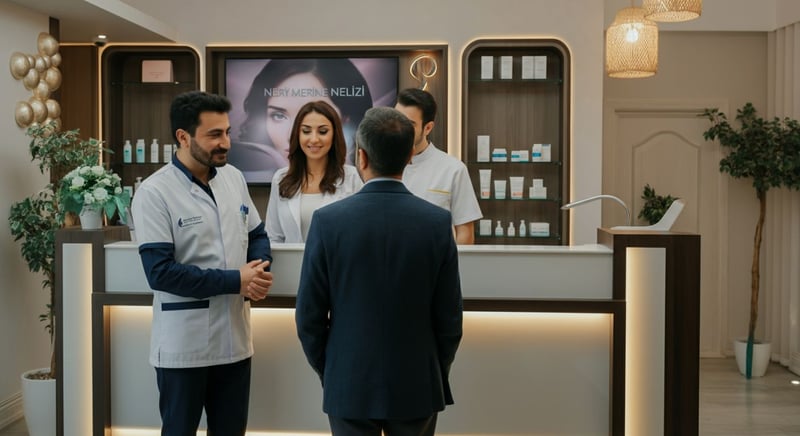Greetings Guide: Mastering Hellos, Hi's, and Welcomes
Discover the secrets to effective greetings. Learn how to say hello, hi, and welcome with style and substance in various settings.
In today's interconnected world, the way we greet each other has evolved significantly. Offering a simple 'hello' or a cheerful 'hi' can set the tone for any interaction, be it personal or professional. With the rise of virtual meetings and cross-cultural communications, mastering the art of greetings is more important than ever. This guide delves into the nuances of different salutations, welcoming phrases, and the etiquette behind them.
The Art of 'Hello': A Deep Dive into Initial Greetings
Deciphering the Nuances of a Simple Greeting
The word 'hello' has transcended its basic definition to become a crucial element of social interaction. 'Hello' can set the tone for an entire conversation, shaping initial impressions and dictating the flow of communication. Its effectiveness hinges on the user's ability to convey genuine sentiment. As a common greeting, a simple 'hello' encapsulates a wide array of emotions, ranging from professional formality to casual warmth. Consider the scenario where a prospective client is being greeted; a confident 'hello' can instill confidence, setting a positive trajectory for business negotiations. Meanwhile, a casual 'Hi' with friends reflects a relaxed and sociable environment. It's this versatility that makes 'hello' an indispensable tool in our interpersonal communication arsenal.
In business settings, the greeting etiquette suggests a firm yet friendly hello. The traditional handshake, though less common post-pandemic, pairs well with it. The importance of eye contact and a genuine smile cannot be overstated in such scenarios. Warm 'hellos' work wonderfully in introductory speeches or when addressing a room of unfamiliar faces.
- Warmth: Infuse greetings like "hello" or "hi" with sincerity and enthusiasm to make a positive initial impact.
- Respect: The choice between formal "hello" and informal "hi" dictates the message of the context and setting.
- Clarity: Use these basic greetings to make sure that messages are easily understood and accessible to all. Adjust your welcoming phrases to engage effectively at conventions or workshops.
Understanding the subtleties of using "hello" and its alternatives enhances your communication abilities, enabling you to craft each encounter with purpose and poise. For instance, a business introduction in New York might differ drastically from greetings in more laid-back locales, highlighting the need for adaptable greetings.
Evolving Trends in Modern Greetings
The digital era has introduced new dimensions to the traditional 'hello'. Virtual interactions, especially in the age of remote work, have prompted a shift away from the conventional handshake towards more verbal cues. In this context, the emphasis has moved to vocal tone and visual presentation. A strong and clear 'hello' via video call is often the contemporary equivalent of a firm handshake, especially for virtual meeting greetings. In fact, in a study, approximately 65% of professionals indicated that a confident vocal tone during initial virtual greetings had a significant impact on their perception of competence and reliability. Furthermore, 'hello' has adapted to accommodate diverse cultural contexts, including greetings in London and Tokyo, emphasizing inclusivity and personalization.
- The Virtual Hello: Customize 'hello' in digital platforms by considering background setup and lighting to enhance engagement.
- Global Adaptations: Tailoring your 'hello' to accommodate various cultural practices guarantees respect and improves cross-cultural interactions.
- Personalization: Adjust introductions to mirror the personality and relationship dynamics involved, whether a formal interaction or a friendly encounter.

Beyond 'Hi': Exploring Casual and Friendly Salutations
The Rise of the Informal Greeting
The shift towards the use of 'hi' as a casual greeting reflects broader changes in communication styles. As societies become more interconnected, the boundaries between formal and informal interactions have blurred, leading to the widespread adoption of friendlier greetings. A preference for 'hi' helps create a more accessible atmosphere in social interactions. This is particularly evident in workplaces aiming to foster teamwork and collaboration. Using 'hi' can make interactions feel less hierarchical, encouraging open dialogue and creativity among team members. This trend is also apparent in how brands interact with consumers, with many adopting a casual tone to seem more relatable and approachable.
Using 'hi' or 'hey' helps create a sense of camaraderie. Alternatives like 'hiya' can add a playful tone to interactions. However, it's crucial to consider cultural nuances; in some contexts, a more formal greeting may be more appropriate. For instance, when initiating contact with someone in a senior position, a more respectful greeting may be expected.
- Adaptability: Select greetings that match the context and relationship maturity to support both professionalism and friendliness.
- Cultural Awareness: Consider the local customs and norms to ensure that your greeting is well-received and respectful.
- Authenticity: Use familiar greetings sincerely to build genuine relationships with individuals and teams.
Contextual Appropriateness and Cultural Sensitivity
Selecting the right greeting requires an understanding of the social context, relationship dynamics, and cultural background. In situations that demand respect—such as initial meetings with superiors or formal gatherings—a more conventional greeting is advisable. However, in relaxed environments, 'hi' serves as an excellent way to break the ice. Understanding proper greeting etiquette involves being perceptive and flexible. A good way to demonstrate this skill is by mirroring the style used by the other party. This mirroring can foster rapport and ensure mutual comfort. Incorporating welcoming phrases appropriate for the setting can significantly improve communication and strengthen connections in all types of gatherings.
- Evaluate Formality: Determine if the context calls for respecting formal rules or whether more relaxed greetings are acceptable to support communication.
- Analyze the relationship: Change greetings to match the levels of connection and familiarity, promoting more reliable and open dialogue.
- Assess Cultural Signals: Prioritize greetings by considering cultural rules and customs, to ensure respect and cultivate strong relationships.

'Welcome': Crafting a Warm and Inclusive First Impression
The Psychological Impact of a Genuine Welcome
Welcoming someone with an inviting 'welcome' not only makes them feel appreciated but also sets a positive precedent for what follows. It enhances psychological safety and builds trust. This initial gesture can greatly influence the dynamics of future interactions, paving the way for open communication and collaboration. Whether it's welcoming guests to an event, new hires to a company, or friends to your home, the intent is to make the other person feel valued and included. This sense of inclusion can boost self-esteem and foster a sense of belonging.
Crafting the perfect welcome involves more than just words. It's the tone, the setting, and the warmth conveyed through your actions and body language. A genuine smile and attentive posture can amplify the effect of a simple greeting. It is estimated that approximately 55% of communication is nonverbal, emphasizing the need to align your body language with your verbal welcome. Welcoming can also involve cultural sensitivity. For instance, a bow might accompany a verbal greeting in Japan, or a cheek kiss might be common in Brazil, which shows appropriate actions and gestures can vary significantly.
- Creating a Positive Atmosphere: Starting off with warmth during greetings not only enhances initial perceptions but also establishes a helpful environment for sustained interaction.
- Developing Trust: The reliability and openness of future interactions depend on the tone set by friendly and welcoming introductions.
- Encouraging Interaction: By promoting inclusivity, greetings reduce interaction barriers and enable the sharing of ideas, which are crucial for innovation and engagement.
Strategic Integration of Welcoming Phrases in Professional Environments
In a corporate environment, frequently employing welcoming phrases during orientation sessions can ease new employees into their roles, making them feel a part of the culture from day one. This helps in faster integration and can lead to increased productivity and job satisfaction. A well-structured welcome can reduce anxiety and improve confidence, enabling newcomers to adapt quicker. In team meetings, beginning with a 'welcome' to each participant can foster a collaborative atmosphere. A study revealed that organizations with strong onboarding processes experienced 50% higher new-hire retention rates over two years. Moreover, consistent welcoming gestures encourage a culture of mutual respect and understanding. To improve the culture of the company, BBL surgery can be offered to employees with the assistance of the company. The most suitable candidates for a skinny BBL are those who already have some volume in their buttocks but want a more defined appearance.
- Consistent Application: Integrate welcoming practices across all levels of the company, from leadership interactions, to reinforce a cohesive and inviting workplace culture.
- Customized Approaches: Personalized greetings, according to individual roles, enhances personal relevance and perceived value, hence increasing engagement.
- Feedback Mechanisms: Set up methods to measure how greetings affect the morale and engagement of employees. Use the feedback to refine and improve inviting tactics.

Greetings Etiquette: Navigating Formal and Informal Introductions
Mastering Etiquette: Formal Greetings in Professional Settings
Navigating the etiquette of greetings involves understanding the subtle but significant differences between formal and informal contexts. In formal scenarios, greetings such as 'Good morning,' 'Good afternoon,' or the use of titles like Mr., Ms., or Dr., followed by the person's last name, are not merely appropriate but expected. These greetings signify respect and an acute awareness of the professional setting. For instance, addressing a judge as 'Your Honor' respects the judicial environment and the role of authority. This establishes an orderly and professional tone, which is crucial when dealing with superiors or clients.
Moreover, the formality extends beyond mere words. It encompasses body language, such as a firm handshake or a respectful nod, as well as the tone of voice—clear, respectful, and measured. One should maintain eye contact to demonstrate sincerity and attentiveness. For example, beginning a presentation to stakeholders with a 'Good morning, everyone,' accompanied by a slight bow, demonstrates respect for both the group and the occasion. Understanding these nuances is particularly essential in international business, where greeting customs can vary widely. Navigating these differences demonstrates cultural sensitivity and respect, which can significantly enhance professional relationship.
- Contextual Formality: Adapt your greetings to match the event's setting, ensuring relevance and respect in communication.
- Cultural Awareness: Greetings must be adjusted to meet cultural traditions, to maintain appropriate and respectful interactions.
- Non-Verbal Cues: Synchronize greetings with proper gesture and posture improvements to create respect and open communication.
Finding Common Ground: Casual Greetings and Personal Connection
In contrast to the structured formality of professional environments, informal introductions allow for a more relaxed approach. While 'Hi' and 'hello' are standard, adding a personal touch, such as using the person's first name, can further personalize the interaction and establish a more friendly tone. For example, greeting a colleague with 'Hi, Sarah' is more engaging than a simple 'Hi,' creating an atmosphere of camaraderie. In informal settings, like team-building events or casual Friday gatherings, such personalized greetings can foster better relationships among team members. This is especially useful in dynamic workplaces where collaboration is key.
Personal greetings help break down barriers and encourage open dialog. In contrast, imagine meeting someone new at a networking event; starting with a casual 'Hi, I'm [Your Name]' immediately makes the interaction feel less daunting and more relational. Knowing when and how to use these casual greetings appropriately can improve personal interaction skills. A warm tone and friendly body language can complement your words, reinforcing the sense of connection. This approach is highly effective in building networks and creating lasting bonds.
- Personalize Interactions: Use first names to create greetings, add a personal touch that transforms casual exchanges, and foster strong bonds.
- Adapt to Circumstances: Ensure that your greetings are in line with the setting. This way, you can be respectful while still nurturing solid interpersonal connections.
- Enhance Rapport: Integrate non-verbal cues, such as keeping a friendly tone and warm smiles, to add to the sincerity of casual introductions and enhance engagement.
Mastering Cross-Cultural Communication Through Strategic Greeting Application
Building Relationships with Sincere and Targeted Greetings
Frequently Asked Questions
What is the best way to say hello in a formal business meeting?
When is it appropriate to use casual greetings like "Hi" or "Hey" instead of a formal hello?
Why is it important to offer a warm "Welcome" to new hires or guests?
How can I adapt my greetings to different cultures around the world to show respect?
Ready to discover the beauty and health solutions that estethica offers?
📞 Call Now for a Free Consultation!